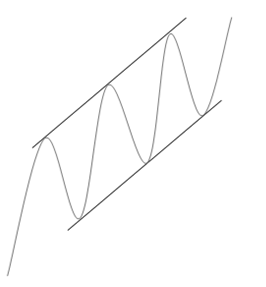A bearish reversal pattern formed by two assembled upward slants is called a rising wedge. To validate rising wedge there must be oscillation between the two lines. These lines must be touched at least twice for validation.
The pattern indicates the shortness of buyers. This one is identified by a continuous reduction of the amplitude of the waves. The lowest will be reached during the first correction on the resistance of the wedge and will form the support. The second wave of increase will then occur, however with lower amplitude, which may appear the weakness of buyers. Another wave will be formed thereafter but prices will increase less and less at the contact with the support. Volumes will then be at their lowest and constantly decrease as the waves. This movement then has almost no buying power which will indicate the willingness of a bearish reversal.
The target price is given by the lowest point that resulted in the formation of the wedge.
Take a look at some statistics about the rising wedge:
– In 82% of cases, there will be a downward exit.
– In 55% of cases, the rising wedge shows a reversal pattern
– In 63% of cases, the goal of the pattern is reached once the support is broken
– In 53% of cases, a pullback arises on the resistance
– In 27% of cases, false breakouts occur
Note the spacing between each contact point the lines must be important otherwise it could be a pennant.
The more that the trend lines are sloped, the more the downward movement will be violent.
False bearish breakouts provide an indication on the side of the exit because in only 3% of cases, when a bearish breakout occurs, the price will go out of the wedge by the top. The risk of running a false bearish break out is quite low.
An upward retracement is normally two times faster than the formation of the wedge.
Pullbacks will be harmful to the performance of the pattern.
A break point is normally located around 60% of the length of the rising wedge.
Rising Wedges that are large will give better performance than narrow wedges.
